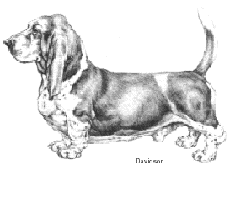Basset Hound
General Information - Basset Hound

Group:
Hound
Size:
Medium
Lifespan:
10 -12 years
Exercise:
Low to medium
Grooming:
Low
Trainability:
Low to medium
Watchdog Ability:
High
Protection Ability:
Low
Area of Origin:
France and UK
Date of Origin:
19th century
Other Names:
None
Original Function:
Trailing rabbits
and hare
History
The strong, sturdy Basset Hound was originated in France but was developed in the UK which also explains the origin of the name: in French, "bas" means "low" which describes this short, low-to-the-ground dog perfectly. Most researchers believe that the breed descends from the now-extinct St. Hubert breed, also from France. While the breed did not arrive in England and North America until the late 1800's and early 1900's, a number of varieties of Basset have existed in Europe for approximately 300 years. The Basset makes an excellent tracker of hare and rabbit due to his excellent scenting ability and stamina. He is able to move through dense bush with relative ease. While he may appear to be a slow-mover at first glance, the Basset Hound is surprisingly athletic and can cover great distances in a short time. In 1960 the first Basset arrived in New Zealand, imported from Victoria, Australia. The breed increased in numbers, gathering support with the formation in 1962 of the Basset Hound Club in Auckland, and is now spread throughout New Zealand.
Temperament
The Basset Hound is a good natured dog breed who gets along well with other pets and children. Basset Hounds are a fairly stubborn breed which goes back to it’s origins as a hunting dog and need patient and consistent training.
Upkeep
The Basset needs mild daily exercise, which can be satisfied by walking on leash or playing in the yard. It is happy to be a house dog or to live outside but enjoys the company of humans or other animals. Its coat needs only minimal grooming, but its ears need regular cleaning.
Basset Hound
A breed standard is the guideline which describes the ideal characteristics, temperament, and appearance of a breed and ensures that the breed is fit for function with soundness essential. Breeders and judges should at all times be careful to avoid obvious conditions and exaggerations, as well as being mindful of features which could be detrimental in any way to the health, welfare or soundness of this breed.
Breed Standard - Basset Hound

Characteristics: A merry hound whose essential function is to hunt, primarily hare, by following a scent. Bold with great activity, stamina and determination. Alert, intelligent and of even temperament.
General Appearance: A sturdy and compactly:built hound, conveying the impression of quality without coarseness.
Head and Skull: Head fair length, powerful in the dog without being coarse, but finer in the bitch; free from frown and excessive wrinkle. Skull slightly domed, moderately wide, with indication of peak. Stop well:defined and dividing the length between occiput and tip of nose as equally as possible. Muzzle not snipy, lips reasonably well flewed. Nose broad and nostrils well expanded; preferably black, but less pigmentation permissible in lighter coloured hounds.
Eyes: Dark brown or hazel, fairly large, not deep set or bulgy, set well apart and with a mild appealing expression .
Ears: Long with round tip, reaching nearly to end of nose when drawn out. Set on low, fine in texture and hanging gracefully close to cheek.
Mouth: Teeth strongly developed. Upper incisors just overlapping and touching outer surface of lower incisors to form scissor bite.
Neck: Sufficiently long to enable hound to come down easily to scent, slightly arched and showing little dewlap.
Forequarters: Shoulder clean and sloping. Forelegs straight and upright, well under the hound, of good substance, strong, hard and round in bone. Not tapering off to feet. Pasterns short. Elbows firm, turning neither in nor out. Height to elbow about half the hound’s height to withers.
Body: Topline straight and level. Chest well let down to below elbow. Ribs well sprung and extending well back. Short between the couplings. Loins powerful and supple, without excessive tuck:up.
Hindquarters: Very muscular about the thighs. Stifles well bent. Hocks firm, well let down and parallel to each other.
Feet: Tight and firm. Well knuckled up and strongly padded. Not hare:footed. Nails short.
Gait: Back level and no roll. Stride free, long:reaching and straight without high action. Hind legs showing drive. Should not move close behind or paddle or plait in front.
Tail: Sturdy and moderate length. Set on high and carried gaily but not curled over back or inclined forward from the root. Well covered with hair, especially on underside.
Coat: Short, dense and weatherproof.
Colour: Any recognised hound colour other than liver. Tip of stern white.
Weight and Size: It is desirable that height from ground to withers should neither exceed 40 cm (16 in) nor fall below 33 cm (13 in).
Note: Male animals should have two apparently normal testicles fully descended into the scrotum.
DNZ No 412
Copyright Dogs New Zealand
01 Jan 2002
Any departure from the foregoing points should be considered a fault and the seriousness with which the fault should be regarded should be in exact proportion to its degree and its effect upon the health and welfare of the dog and on the dog’s ability to perform its traditional work.




